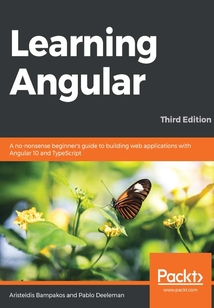舉報 

會員
Learning Angular
Angular,lovedbymillionsofwebdevelopersaroundtheworld,continuestobeoneofthetopJavaScriptframeworksthankstoitsregularupdatesandnewfeaturesthatenablefast,cross-platform,andsecurefrontendwebdevelopment.WithAngular,youcanachievehighperformanceusingthelatestwebtechniquesandextensiveintegrationwithwebtoolsandintegrateddevelopmentenvironments(IDEs).UpdatedtoAngular10,thisthirdeditionoftheLearningAngularbookcoversnewfeaturesandmodernwebdevelopmentpracticestoaddressthecurrentfrontendwebdevelopmentlandscape.IfyouarenewtoAngular,thisbookwillgiveyouacomprehensiveintroductiontohelpyougetyouupandrunninginnotime.You'lllearnhowtodevelopappsbyharnessingthepoweroftheAngularcommand-lineinterface(CLI),writeunittests,styleyourappsbyfollowingtheMaterialDesignguidelines,andfinallydeploythemtoahostingprovider.ThebookisespeciallyusefulforbeginnerstogettogripswiththebarebonesoftheframeworkneededtostartdevelopingAngularapps.Bytheendofthisbook,you’llnotonlybeabletocreateAngularapplicationswithTypeScriptfromscratchbutalsoenhanceyourcodingskillswithbestpractices.
目錄(132章)
倒序
- 封面
- 版權信息
- Why subscribe?
- Contributors About the authors
- About the reviewer
- Packt is searching for authors like you
- Preface
- Who this book is for
- What this book covers
- To get the most out of this book
- Download the example code files
- Conventions used
- Get in touch
- Reviews
- Section 1: Getting Started with Angular
- Chapter 1: Building Your First Angular App
- Technical requirements
- It's just Angular – introducing semantic versioning
- Introducing Angular
- Setting up our workspace with Angular CLI
- Hello Angular
- IDEs and plugins
- Summary
- Chapter 2: Introduction to TypeScript
- The history of TypeScript
- Types in TypeScript
- Functions lambdas and execution flow
- Common TypeScript features
- Classes interfaces and inheritance
- Decorators in TypeScript
- Advanced types
- Modules
- Summary
- Section 2: Components – the Basic Building Blocks of an Angular App
- Chapter 3: Component Interaction and Inter-Communication
- Technical requirements
- Creating our first component
- Configuring a component
- Interacting with the template
- Communicating with other components
- Encapsulating CSS styling
- Change detection strategies
- Introducing the component lifecycle
- Summary
- Chapter 4: Enhance Components with Pipes and Directives
- Technical requirements
- Introducing directives
- Transforming elements using directives
- Manipulating data with pipes
- Building custom pipes
- Building custom directives
- Summary
- Chapter 5: Structure an Angular App
- Technical requirements
- Organizing components into modules
- Configuring the application
- How dependency injection works in Angular
- Summary
- Chapter 6: Enrich Components with Asynchronous Data Services
- Technical requirements
- Strategies for handling asynchronous information
- Reactive functional programming in Angular
- Creating a backend API-the Angular way
- Communicating data over HTTP
- Authenticating with HTTP
- Handling HTTP errors
- Unsubscribing from observables
- Summary
- Section 3: User Experience and Testability
- Chapter 7: Navigate through Components with Routing
- Technical requirements
- Introducing the Angular router
- Creating an Angular app with routing
- Separating our app into feature routing modules
- Passing parameters to routes
- Enhancing navigation with advanced features
- Summary
- Chapter 8: Orchestrating Validation Experiences in Forms
- Technical requirements
- Introducing forms to web apps
- Data binding with template-driven forms
- Using reactive patterns in Angular forms
- Validating controls in a reactive way
- Modifying forms dynamically
- Creating elegant reactive forms
- Building a custom validator
- Manipulating form data
- Watching state changes and being reactive
- Summary
- Chapter 9: Introduction to Angular Material
- Technical requirements
- Introducing Material Design
- Introducing Angular Material
- Adding core UI controls
- Introducing the Angular CDK
- Designing layouts using flexbox
- Summary
- Chapter 10: Giving Motion to Components with Animations
- Technical requirements
- Creating animations with plain vanilla CSS
- Introducing Angular animations
- Animating components programmatically
- Summary
- Chapter 11: Unit test an Angular App
- Technical requirements
- Why do we need tests?
- The anatomy of a unit test
- Introducing unit tests in Angular
- Testing components
- Testing services
- Testing pipes
- Testing routing
- Testing directives
- Testing reactive forms
- Summary
- Section 4: Deployment and Practice
- Chapter 12: Bringing an Angular App to Production
- Technical requirements
- Building an Angular app
- Limiting the application bundle size
- Optimizing the application bundle
- Deploying an Angular app
- Summary
- Chapter 13: Develop a Real-World Angular App
- Technical requirements
- Scaffolding the application structure
- Implementing core features
- Adding heroes functionality
- Integrating the missions module
- Summary
- Other Books You May Enjoy
- Leave a review - let other readers know what you think 更新時間:2021-06-11 18:24:26
推薦閱讀
- Progressive Web Apps with React
- C語言程序設計基礎與實驗指導
- Oracle JDeveloper 11gR2 Cookbook
- 持續(xù)輕量級Java EE開發(fā):編寫可測試的代碼
- 區(qū)塊鏈技術進階與實戰(zhàn)(第2版)
- Sails.js Essentials
- 大學計算機基礎實訓教程
- Python Programming for Arduino
- C語言從入門到精通
- 官方 Scratch 3.0 編程趣味卡:讓孩子們愛上編程(全彩)
- Head First Kotlin程序設計
- Practical Responsive Typography
- Spring Microservices
- Python程序設計
- 威脅建模:設計和交付更安全的軟件
- Drools 8規(guī)則引擎:核心技術與實踐
- Python游戲編程項目開發(fā)實戰(zhàn)
- CentOS High Performance
- Getting Started with Kubernetes
- 微信小程序開發(fā)
- 程序員面試筆試寶典
- Mastering Grunt
- Linux C編程從入門到精通(“十二五”國家重點圖書出版規(guī)劃項目)
- Test-Driven Java Development
- 同構:編程中的數(shù)學
- Drupal 7 Media
- Excel 2010 VBA編程與實踐
- Android的設計與實現(xiàn):卷I
- Mastering OpenCV 4 with Python
- 算法競賽寶典(第三部):基礎數(shù)據(jù)結構

